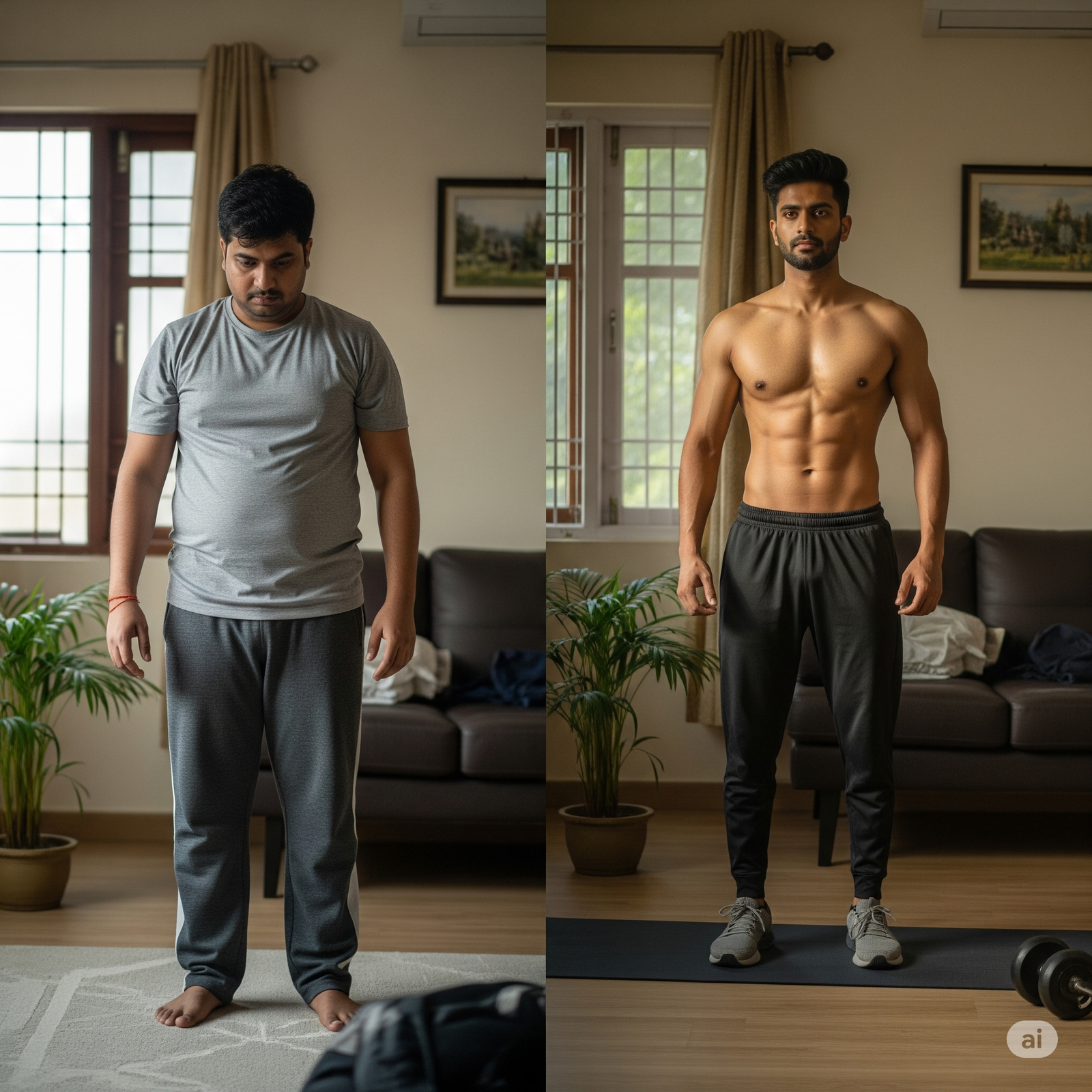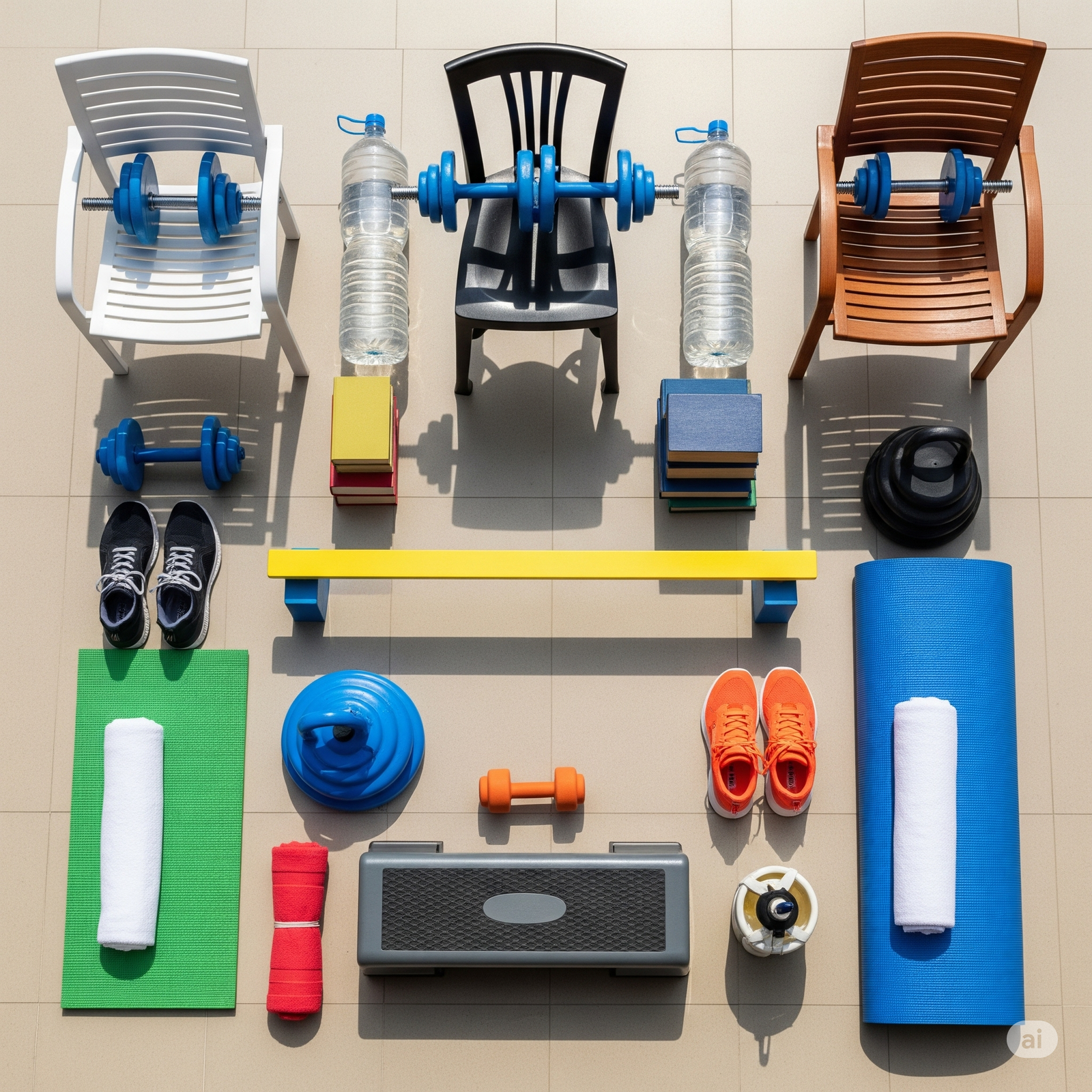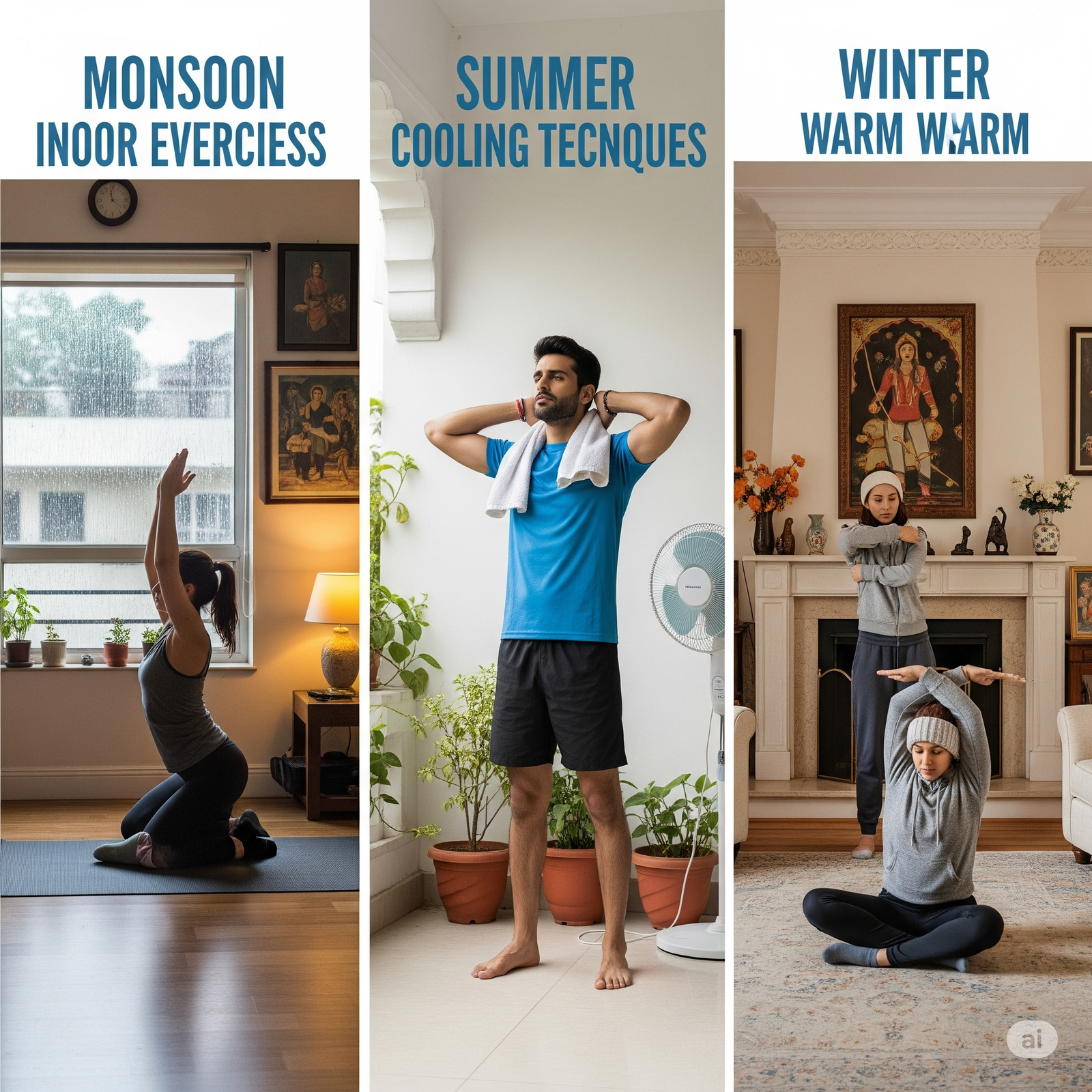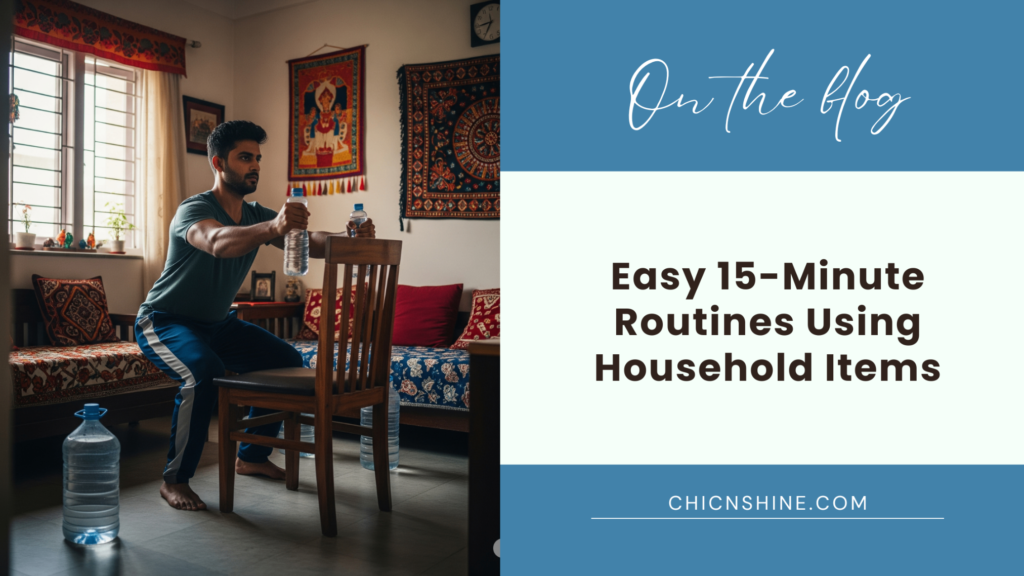You don’t need a gym. You need a water bottle, a plastic chair, and about one square meter of floor space.
Living in a shoebox apartment in Mumbai, I used to think fitness required gym memberships, protein powders, and enough free time to battle traffic twice a day. Spoiler alert: it doesn’t.
During lockdown, stuck inside and losing my mind, I stumbled into the most effective fitness hack of my life—using common household items for 15-minute daily workouts. No expensive gear, no equipment, no judgmental bros at the gym doing bicep curls in the mirror.
This post shows you exactly how I turned my cluttered living room into a surprisingly efficient home gym—with stuff you probably already own.
Why Fitness in Indian Homes Is a Whole Different Game
Let’s be honest: most international “at-home fitness guides” are written for people with basements, Pelotons, and private saunas. Meanwhile, we’re dodging ceiling fans, sharing rooms with nosy aunties, and trying to do push-ups next to the gas cylinder.
Here’s the deal:
-
Indian homes = limited space
-
Weather = monsoon or melt-your-face hot
-
Time = LOL what time?
-
Motivation = evaporates by 7:42 PM
That’s why home fitness here has to be creative, quick, and realistic. No need for resistance bands or yoga blocks when you’ve got buckets, stools, and heavy rice bags just lying around.
My Breakup with Gyms (And Why I’m Not Going Back)
Once upon a time, I paid ₹3,000/month to stand in line for the treadmill at a sweaty gym that smelled like regret and protein powder.
Then I realized:
-
I was spending more time commuting than exercising
-
The gym closed before I finished work half the week
-
I kept skipping sessions because I hated being there
What did work?
A spontaneous chair dip session in my living room.
Squats holding a 5-liter water bottle.
Push-ups against the edge of my kitchen counter.
And for the first time? I wasn’t stressed, late, or broke.
That’s when I built my own 15-minute routine. And honestly? I’m in better shape now than I ever was in the gym.

The Science Behind Household Item Workouts
What many people don’t realize is that resistance is resistance, regardless of whether it comes from expensive gym equipment or a sturdy plastic chair. The human body responds to progressive overload and consistent challenges, which can be achieved just as effectively with household items as with professional equipment. My research into exercise physiology, combined with insights from fitness professionals on various online platforms, has confirmed that bodyweight exercises combined with household items can provide comprehensive fitness benefits.
The key principle I’ve learned is that functional fitness – the kind that improves your daily life activities – is often better achieved through exercises that mimic real-world movements. Indian household items are perfect for this because they’re designed for daily use and can provide the varied resistance and stability challenges that our bodies need for complete fitness development.
Moreover, the psychological benefits of home workouts cannot be understated. Training in familiar surroundings eliminates the anxiety and self-consciousness that many people experience in gym environments. This comfort factor has significantly improved my consistency and enjoyment of exercise, leading to better long-term results.
Essential Household Items for Your Fitness Arsenal
Every Indian home contains a goldmine of fitness equipment disguised as everyday objects. Through my experimentation, I’ve identified several categories of household items that can form the foundation of any effective workout routine. Water bottles, whether plastic or glass, serve as excellent weights and can be adjusted for different resistance levels simply by changing the amount of water they contain.
Sturdy plastic chairs, which are common in most Indian households, become versatile pieces of equipment for everything from step-ups and tricep dips to incline push-ups and single-leg squats. The key is ensuring the chair can support your body weight safely – I always test this before incorporating any chair-based exercises into my routine.
Amazon Suggestion: [ non-slip yoga mat for floor exercises and better grip during home workouts ]
Additionally, I’ve found that heavy household items like large water containers, bags of rice or dal, and even heavy books can serve as excellent weights for strength training. The irregular shapes of these items provide additional stability challenges that can improve your functional strength more effectively than traditional dumbbells.

Towels, which every home has in abundance, become crucial for stretching, resistance exercises, and even cardio movements. The friction and flexibility of towels allow for unique exercise variations that target muscles in ways that traditional equipment cannot replicate.
The Complete 15-Minute Morning Routine (No Gym, No Excuses)
This is the exact 15-minute routine I use every morning to stay fit in a one-bedroom Mumbai apartment with zero equipment and zero patience.
It’s short. It’s effective. And it’s powered entirely by common household items—not by “influencer energy” or ₹80,000 treadmills.
Step 1: Dynamic Warm-Up (2 minutes)
Goal: Wake up your muscles and get blood flowing without needing a yoga mat or balcony.
-
March in place — 30 seconds
-
Arm circles (forward and backward) — 30 seconds
-
Step-ups on stairs or low platform — 1 minute
(No stairs? Just alternate high knees in place while swinging your arms like you’re chasing an auto.)
Step 2: Strength & Cardio Circuit (10 minutes)
Here’s a rotation you can loop through 2–3 times depending on energy levels:
Lower Body
-
Chair Squats (12 reps)
Use a sturdy plastic chair to guide form. Squat until your butt just taps the seat.
Upper Body
-
Water Bottle Shoulder Press (10 reps)
Fill two 1-liter bottles and raise overhead with control. Too easy? Use 2-liter ones. -
Bicep Curls (12 reps)
Same bottles. Bonus: switch to bags of rice if you’re feeling chaotic.
Core
-
Water Jug Russian Twists (30 seconds)
Sit, hold a heavy container (or a stack of books), and twist side to side. -
Plank Hold on Towel (30 seconds)
Hands on floor, toes on towel = surprisingly intense core fire.
Triceps & Chest
-
Chair Dips (10 reps)
Use the edge of a stable seat. Bend elbows, dip down, push back up. -
Incline Push-ups (10 reps)
Hands on a surface (table or chair), feet on floor. Scale up to floor push-ups later.
Step 3: Cool Down + Stretch (3 minutes)
You are technically alive and moving now, congrats. Don’t skip this part.
-
Hamstring stretch over chair
-
Quad stretch (hold a wall, you’re not impressing anyone)
-
Shoulder rolls & neck circles
-
Deep inhale like you’re zen.
-
Exhale like you didn’t almost skip this whole thing.
Customize Based on Mood
-
Low Energy? Slow it down, hold movements longer. Quality > quantity.
-
High Energy? Add rounds or bump up weights (aka full jugs or laundry baskets).
-
No Energy? Do one round and lie flat like a responsible adult.
Cardio Solutions for Small Indian Homes
Cardiovascular fitness presents unique challenges in small Indian homes, but I’ve discovered numerous solutions that provide excellent results without disturbing neighbors or family members. Stair climbing, when available, offers one of the most effective cardio workouts possible. Even a small flight of stairs can provide intense cardiovascular benefits when used creatively.
For homes without stairs, I’ve developed sequences that combine household item movements with bodyweight exercises to create high-intensity intervals. Using chairs for step-ups, water bottles for overhead movements, and floor space for mountain climbers creates a comprehensive cardio routine that rivals any gym equipment.
The key insight I’ve gained is that effective cardio is about elevating heart rate and maintaining intensity, not about specific equipment. By combining household items with bodyweight movements and focusing on minimal rest periods, I’ve created cardio routines that are both effective and sustainable for long-term practice.
Nutrition Integration for Home Fitness Success
My experience with a no-gym home workout routine in India has taught me that nutrition plays an equally important role as an exercise in achieving fitness goals. The convenience of home workouts allows for better integration of pre and post-workout nutrition, which has significantly improved my results and recovery times.
Working out at home means I can prepare fresh, healthy meals immediately after exercise, maximizing the anabolic window for muscle recovery and growth. I’ve developed simple nutrition strategies using common Indian ingredients that support my fitness goals while being practical for busy lifestyles.
Amazon Suggestion: [ high-quality protein powder suitable for Indian dietary preferences ]
The cost savings from avoiding gym memberships have allowed me to invest in better nutrition, which has created a positive cycle of improved health and fitness. This integration of exercise and nutrition at home has been one of the most significant factors in my successful transformation.
Overcoming Common Challenges and Obstacles
Throughout my journey, I’ve encountered and overcome numerous obstacles that are common to anyone attempting a no-gym home workout routine in India. Space limitations initially seemed insurmountable, but I learned to maximize vertical space and use furniture creatively to expand my workout area without permanently rearranging my living space.
Family distractions and interruptions were perhaps the biggest challenge I faced. However, I discovered that early morning workouts, before the household becomes active, provide the most consistent and peaceful exercise environment. Additionally, involving family members occasionally has turned some of my workouts into fun, bonding activities that everyone enjoys.

Motivation and consistency proved to be ongoing challenges that required creative solutions. I’ve found that tracking progress through photos, measurements, and performance improvements provides better motivation than traditional gym metrics. Additionally, connecting with online communities and sharing experiences has created accountability and support that rivals any gym environment.
Technology Integration for Enhanced Results
Modern technology has significantly enhanced my home workout experience, and I’ve learned to integrate various digital tools to maximize the effectiveness of my no-gym home workout routine in India. Fitness apps provide structured guidance, while online communities offer support and motivation that were previously only available through gym memberships.
Video tutorials and online fitness programs have allowed me to learn proper form and discover new exercises that I can adapt to my household items. The key is finding content that aligns with the reality of Indian homes and lifestyles rather than following routines designed for fully equipped gyms or large spaces.
Social media and fitness forums have become valuable resources for troubleshooting challenges, sharing experiences, and discovering new household item exercises. This virtual community has provided the support and motivation that traditional gym environments offer while being accessible 24/7 from the comfort of my home.
Long-term Sustainability and Progression
The most significant advantage of my no-gym home workout routine in India has been its sustainability over time. Unlike gym memberships that require ongoing financial commitments and travel time, home workouts using household items require no additional investment once established. This sustainability has allowed me to maintain consistency even during challenging periods of life.
Progression remains possible and necessary even with household items. I’ve learned to increase difficulty through various methods: adjusting resistance by adding water to bottles, changing angles and positions, increasing repetitions and sets, combining exercises into complex movements, and reducing rest periods between exercises. These progression techniques ensure continuous improvement without requiring new equipment.
The psychological benefits of mastering fitness independence cannot be overstated. Knowing that I can maintain and improve my fitness regardless of external circumstances has provided a sense of empowerment and confidence that extends beyond physical health into other areas of life.
Weather and Seasonal Adaptations
India’s diverse climate requires fitness routines that can adapt to extreme weather conditions, and home workouts provide the perfect solution to this challenge. During monsoon seasons when outdoor exercise becomes impossible, my household item routines ensure that fitness goals remain achievable and consistent.
Summer months, particularly in northern India, make outdoor exercise dangerous during peak hours. Home workouts allow for flexible scheduling that avoids the hottest parts of the day while maintaining air conditioning or fan cooling for comfort and safety.

Winter months in many parts of India require different warm-up and preparation strategies. Home workouts allow for gradual warming in controlled environments, reducing injury risk and improving exercise enjoyment during colder periods.
Frequently Asked Questions
Can I build muscle using only household items for my no-gym home workout routine in India?
Absolutely! I've experienced significant muscle development using household items, and the science supports this completely. Muscle growth occurs when you provide progressive resistance and adequate recovery, which can be achieved with water bottles, chairs, and other household items. The key is consistency and gradually increasing the challenge. I've built more functional strength with household items than I ever achieved in traditional gyms because these exercises often engage stabilizing muscles that machines neglect.
How do I ensure I'm getting enough cardio without expensive equipment?
Cardiovascular fitness can be achieved excellently with household items and bodyweight exercises. I create high-intensity intervals using stairs, and chairs for step-ups, and combining movements like jumping jacks with household item exercises. The key is maintaining an elevated heart rate for sustained periods. Some of my most intense cardio sessions involve nothing more than household stairs and creative sequencing of movements.
What if I live in a small apartment with neighbors below - can I still do effective workouts?
This was one of my biggest concerns initially, but I've developed numerous low-impact routines that provide excellent results without disturbing neighbors. Chair exercises, wall push-ups, isometric holds, and controlled resistance movements using household items can be incredibly effective while remaining nearly silent. I focus on slow, controlled movements during early morning or late evening sessions, and I've never received complaints while achieving excellent fitness results.
How do I know if I'm progressing without gym equipment to measure my improvements?
Progress tracking at home is more comprehensive than gym measurements. I monitor improvements through increased repetitions, longer exercise durations, better form, improved daily activities, enhanced energy levels, and regular progress photos. I also track how many water bottles I can lift, how long I can hold positions, and how quickly I recover between exercises. These functional improvements often provide better indicators of real fitness progress than traditional gym metrics.
Final Thoughts: Fitness Isn’t About Fancy Gyms. It’s About Showing Up.
You don’t need a gym membership. You don’t need fancy equipment. Heck, you don’t even need shoes some days.
What you do need is 15 minutes, a few things lying around your house, and a willingness to look a little ridiculous while doing squats next to your refrigerator.
This routine isn’t about becoming a bodybuilder—it’s about building consistency in real-world Indian homes, where space is tight, time is tighter, and excuses are unlimited.
So whether you’re doing push-ups against your kitchen counter or lifting a water bottle like it’s a barbell from hell—just start. Because one thing I’ve learned after all the gym guilt, skipped workouts, and overpriced protein jars is this:
The workout you’ll actually do is always better than the one you don’t.
Now go take control of your morning. And maybe wipe that chair you were sweating on.


